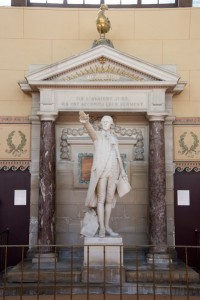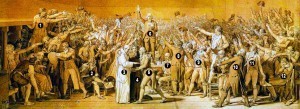The Revolution is usually dated from the Fall of the Bastille on 14 July, but on 20 June the IIIrd Estate swore an oath to overthrow the Fundamental Laws and the Organic Constitution of France.
From Alpha History
The Tennis Court Oath (in French, Serment du jeu de Paume) was a commitment to a national constitution and representative government, taken by delegates at the Estates-General at Versailles. It has become one of the most iconic scenes of the French Revolution.
Summary
On the morning of June 20th 1789, deputies in the newly formed National Assembly gathered to enter the meeting hall at the Hôtel des Menus-Plaisirs at Versailles, only to find the doors locked and guarded by royal troops.
Interpreting this as a hostile move by King Louis XVI and his ministers, the National Assembly proceeded to the nearest available space, one of Versailles’ indoor tennis courts.
Gathering on the floor of this court, the 577 deputies took an oath, hastily written by Emmanuel Sieyès and administered by Jean-Sylvain Bailly. Together, they pledged to remain assembled until a new national constitution had been drafted and implemented.
Like the fall of the Bastille a fortnight later, the Tennis Court Oath became a memorable gesture of revolutionary defiance against the old regime. The prominent artist Jacques-Louis David later immortalised the oath in a dramatic portrait.
Background
The Tennis Court Oath followed several days of tension and confrontation at the Estates-General. Frustrated by the procedures of the Estates-General, particularly the use of voting by order, the Third Estate spent the first week of June contemplating what action to take.
On June 10th, Sieyès rose before the Third Estate deputies and proposed inviting deputies from the other Estates to form a representative assembly. This occurred on June 17th when deputies of the Third Estate, along with several nobles and clergymen, voted 490-90 to form the National Assembly.
Despite this representing a clear challenge to royal authority, it took several days for the king to respond. Following the advice of Jacques Necker, Louis scheduled a séance royale (‘royal session’) involving all three Estates on June 23rd. There the king planned to unveil reforms aimed at winning the support of moderates, who he believed held the numbers in the Third Estate. These plans were thwarted by the events of June 20th.
Meeting hall locked

Historians have long mused over why the doors of the Menus-Plaisirs were locked. Some have suggested it was a deliberate royal tactic, an attempt to stop the Estates meeting before the séance royale. It was more likely to have accidental, a procedural order that assumed the Estates would not meet again until June 22nd (June 20th was a Saturday).
Whatever the reason, the Third Estate deputies interpreted the barred doors as a hostile act, evidence of their suspicious mood. They left the Menus-Plaisirs and proceeded to the next open building, the Jeu de Paume, a real tennis court used by Louis XIV.
The oath was administered by Jean-Sylvain Bailly and signed by 576 members of the Third Estate. There was one abstention: Joseph Martin d’Auch, the deputy from Castelnaudary, refused to sign the oath on the grounds that it insulted the king. The full text of the oath read:
“The National Assembly, considering that it has been summoned to establish the constitution of the kingdom, to effect the regeneration of public order, and to maintain the true principles of monarchy; that nothing can prevent it from continuing its deliberations in whatever place it may be forced to establish itself; and, finally, that wheresoever its members are assembled, there is the National Assembly… It decrees that all members of this Assembly shall immediately take a solemn oath not to separate, and to reassemble wherever circumstances require, until the constitution of the kingdom is established and consolidated upon firm foundations; and that, the said oath taken, all members and each one individually shall ratify this steadfast resolution by signature.”
David’s rendition
In 1790, the artist Jacques-Louis David began preparations for a grand painting to visualise and honour the swearing of the Tennis Court Oath. While the events of the revolution prevented David from completing the painting, his preliminary engraving (above) survives and provides the best-known representation of the events of June 20th.
David was not at Versailles himself and so was not witness to the Tennis Court Oath. Instead, he relied on the testimony of others who had watched the Oath from the higher galleries.
Among the prominent revolutionaries shown in David’s engraving are Isaac Le Chapelier (1); the journalist Bertrand Barère (2); three religious leaders Dom Gerle (3), Henri Grégoire (4) and Jean-Paul Rabaut Saint-Étienne (5); the famous astronomer and later mayor of Paris who administered the oath, Jean-Sylvain Bailly (6); the author of the oath Emmanuel Sieyès (7); the future mayor of Paris Jérôme Pétion (8); Maximilien Robespierre (9); the constitutional monarchists Honore Mirabeau (10) and Antoine Barnave (11); and the lone abstainer from the oath, Joseph Martin d’Auch (12).
The king’s response
On June 22nd, two days after the Tennis Court Oath, the deputies of the Third Estate met at a Versailles church, along with 150 clergymen and two nobles. The king appeared and instructed those present to rejoin their Estates to continue their deliberations separately – but the leaders of the Third Estate refused.
When the séance royale opened the following day, Louis began by unveiling his reforms. The king promised a degree of representative government, with regular sessions of the Estates-General. The taxation system would be overhauled in consultation with the Estates-General, the legal system would be improved and lettres de cachet abolished.
While Louis was prepared to make political concessions and reforms, however, he would not accept the adoption of a constitution or fundamental changes to the Ancien Régime. The Three Estates were an “ancient distinction” and an “integral part of the constitution”, the king declared, and would remain intact.
The Third Estate defiant
Had Louis XVI proposed these reforms in 1788 or earlier, it may well have saved his throne. But as historian Richard Cobb puts it, the Tennis Court Oath had “cut the ground from under the king’s feet”. Maintaining the Three Estates in their ancient form was unacceptable to the Third Estate, particularly if it continued to be outvoted by the other two Estates. Accepting the king’s reforms would also require the dissolution of their National Assembly.
When the séance royale ended and the king left the chamber, the deputies of the National Assembly defiantly remained. Stirred up by orators like Mirabeau, Bailly and Barnave, they affirmed the pledges made three days earlier in the Tennis Court Oath.
The National Assembly continued to defy the king’s orders and remain in session. When confronted by one of the king’s envoys and asked to leave the hall, Mirabeau made his famous remark: “Go tell your masters who have sent you that we shall not leave, except by the force of bayonets”.
Louis relents

When the king was told of this defiance he responded with indifference, reportedly muttering “f**k it, let them stay”. Over the next three days dozens of clergymen and nobles – including the Duke of Orleans, a member of the royal court and a distant relative of the king – crossed the floor to join the National Assembly.
On June 27th, the king backed down completely and ordered the remaining deputies of the First and Second Estates to join the National Assembly, thus giving it apparent constitutional legitimacy.
The Tennis Court Oath – which was both a revolutionary act and an expression of popular sovereignty – had succeeded in forcing a royal back down. With one fell swoop, Louis XVI had abolished the Three Estates as separate political orders.
While conservatives were furious about what the king had surrendered, the news triggered great excitement and rejoicing in Paris. The bourgeois revolution, it seems, had won the day – but with large numbers of royal troops massing near Versailles and on the outskirts of Paris, there was still more confrontation to come.
A historian’s view:
“Jacques-Louis David recognised the gravity of the moment and the enthusiasm it released. He caught history in the making. Faces and bodies are frozen in an instant of the highest emotional intensity. The delegates are possessed by a common mission, which consists in preserving their newly won unity. The oath sworn in the tennis court outside the royal palace in Versailles… marks the beginning of the French Revolution. Language is at a loss as one tries to capture David’s visualisation of a unity manifesting itself as quantity.”
Stefan Jonsson

No comments:
Post a Comment
Comments are subject to deletion if they are not germane. I have no problem with a bit of colourful language, but blasphemy or depraved profanity will not be allowed. Attacks on the Catholic Faith will not be tolerated. Comments will be deleted that are republican (Yanks! Note the lower case 'r'!), attacks on the legitimacy of Pope Leo XIV as the Vicar of Christ, the legitimacy of the House of Windsor or of the claims of the Elder Line of the House of France, or attacks on the legitimacy of any of the currently ruling Houses of Europe.